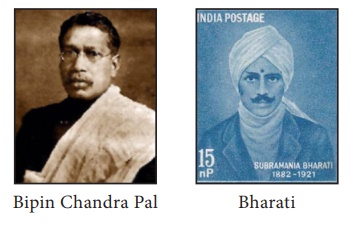Freedom Struggle in Tamil Nadu - Swadeshi Movement | 10th Social Science : History : Chapter 9 : Freedom Struggle in Tamil Nadu
Chapter: 10th Social Science : History : Chapter 9 : Freedom Struggle in Tamil Nadu
Swadeshi Movement
Swadeshi Movement
The
partition of Bengal (1905) led to the Swadeshi Movement and changed the course
of the struggle for freedom. In various parts of India, especially Bengal,
Punjab and Maharashtra popular leaders emerged. They implemented the programme
of the Calcutta Congress which called upon the nation to promote Swadeshi
enterprise, boycott foreign goods and promote national education.
(a) Response in Tamilnadu
V.O.
Chidambaranar, V. Chakkaraiyar, Subramania Bharati and Surendranath Arya were
some of the prominent leaders in Tamilnadu. Public meetings attended by
thousands of people were organised in various parts of Tamilnadu. Tamil was
used on the public platform for the first time to mobilise the people.
Subaramania Bharati’s patriotic songs were especially important in stirring
patriotic emotions. Many journals were started to propagate Swadeshi ideals. Swadesamitran and India were prominent journals.
The extremist leader Bipin Chandra Pal toured Madras and delivered lectures
which inspired the youth. Students and youth participated widely in the
Swadeshi Movement.

Swadeshi Steam Navigation Company
One of the
most enterprising acts in pursuance of swadeshi
was the launching of the Swadeshi Steam Navigation Company at Thoothukudi by
V.O. Chidambaranar. He purchased two ships Gallia
and Lavo and plied them between
Thoothukudi and Colombo.
Tirunelveli Uprising
V.O.C joined with Subramania Siva in organising the mill workers in Thoothukudi and Tirunelveli. In 1908, he led a strike in the European-owned Coral Mills. It coincided with the release of Bipin Chandra Pal. V.O.C and Subramania Siva, who organised a public meeting to celebrate the release of Bipin, were arrested. The two leaders were charged with sedition and sentenced to rigorous imprisonment. Initially V.O.C. was given a draconian sentence of two life imprisonments. The news of the arrest sparked riots in Tirunelveli leading to the burning down of the police station, court building and municipal office. It led to the death of four people in police firing. V.O.C. was treated harshly in prison and was made to pull the heavy oil press. To avoid imprisonment Subramania Bharati moved to Pondicherry which was under French rule. Bharati’s example was followed by many other nationalists such as Aurobindo Ghosh and V. V. Subramanianar.

(b) Revolutionary Activities in Tamil Nadu
Pondicherry
provided a safe haven for the revolutionaries. Many of these revolutionaries in
Tamil Nadu were introduced and trained in revolutionary activities at India
House in London and in Paris. M.P.T. Acharya, V.V. Subramanianar and T.S.S.
Rajan were prominent among them. Revolutionary literature was distributed by
them in Madras through Pondicherry. Radical papers such as India, Vijaya and Suryodayam
came out of Pondicherry.

Ashe Murder
In 1904
Nilakanta Brahmachari and others started Bharata Matha Society, a secret society. The objective was to
kill British officials and thereby kindle patriotic fervour among the people.
Vanchinathan of Senkottai, was influenced by this organisation. On 17 June 1911
he shot dead Robert W.D’E. Ashe, Collector of Tirunelveli in Maniyachi
Junction. After this he shot himself.
(c) Annie Besant and the Home Rule Movement
While the
extremists and revolutionaries were suppressed with an iron hand, the moderates
hoped for some constitutional reforms. However, they were disappointed with the
Minto-Morley reforms as it did not provide for responsible government.
Thus when
the national movement was in its ebb, Annie Besant, an Irish lady and leader of
the Theosophical Society, proposed the Home Rule Movement on the model of Irish
Home Rule League. She started Home Rule League in 1916 and carried forward the
demand for home rule all over India. G.S. Arundale, B.P. Wadia and C.P.
Ramaswamy assisted her in this campaign. They demanded home rule with only a
nominal allegiance to British Crown. She started the newspapers New India and Commonweal to carry forward her agenda. She remarked, “Better bullock carts and freedom than a train deluxe with subjection”. Under the
Press Act of 1910 Annie Besant was asked to pay hefty amount as security. She
wrote two books, How India wrought for
Freedom and India: A Nation and a pamphlet on self-government.
Related Topics